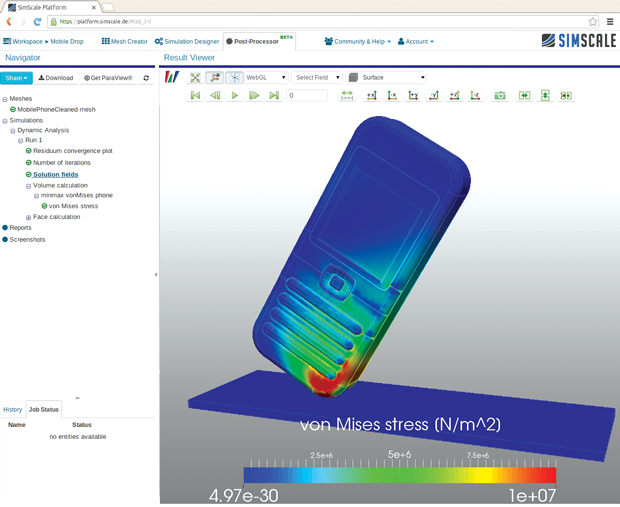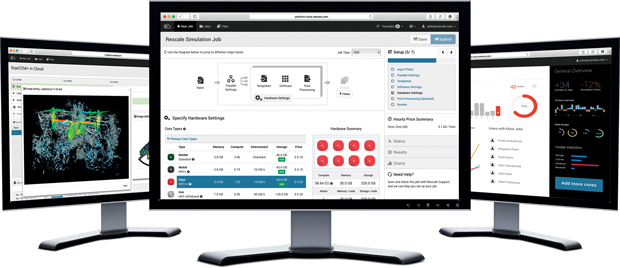
With SimScale, engineers can run simulations directly from a CAD-neutral Web browser. Image courtesy of SimScale.
Latest News
November 2, 2015
 With SimScale, engineers can run simulations directly from a CAD-neutral Web browser. Image courtesy of SimScale.
With SimScale, engineers can run simulations directly from a CAD-neutral Web browser. Image courtesy of SimScale.The way that engineers simulate is changing. In the last few years, more technology and software has emerged making the necessary toolsets more accessible for non-analysts. But it’s not just the software that’s changed; the way companies are structuring their offerings has also shifted. Engineers and firms can now purchase software and hardware as a service — offering flexibility, accessibility and mobility.
Because they can use software, servers and the cloud as little or as often as they need, engineers can get a taste of programs or toolsets that might not be accessible otherwise. This has become more common for CAE platforms as engineers are bringing simulation further forward in the design process.
Acronyms, Acronyms, and More Acronyms
Within the industry, “as-a-service” offerings are typically categorized into three main silos: Software as a Service (SaaS), Platform as a Service (PaaS) and Infrastructure as a Service (IaaS). While all of these options leverage the cloud, the type of technology that they provide differs. According to Computenext, these acronyms can be described with the following definitions:
• SaaS: A Web browser providing a point of contact for software on servers.
• PaaS: An environment to run an operating system and servers for deploying specific software programs.
• IaaS: Server and cloud computing access via a dashboard and/or API (application programming interface).
These different configurations offer organizations a way to access more power for simulation not only when it’s needed, but also at a more affordable price point.
“What we often see is that simulation is a very volatile thing that [engineers deal with]. Compared to CAD, which they use very regularly, simulation might spike during a development project and [be followed] by several weeks where it is not used at all,” says David Heiny, managing director of SimScale. Despite the varying levels of support and technology, these “as-a-service offerings” all provide engineers and teams with an option to quickly implement extra simulation resources when needed.
“The main priority of simulation software should always be getting the job done reliably, robust and fast. There’s also a huge technical overhead, so when we started SimScale, we saw that the Web browser will evolve to something that is capable of providing access to a simulation engineering workflow,” Heiny says. “It [also] really comes down to providing access to simulation methods and capacities in a more convenient manner.”
In using the Web browser as the basis for its software, Heiny says it not only offers mobility, but is also a more intuitive format for engineers that enables them to start simulating quickly. To access the resources SimScale provides, users simply create an account, upload a model and start running simulations.
Beyond the Software
However, running simulations requires more than software. Engineers still need access to computing power that can physically calculate results. With providers such as UberCloud and Rescale, teams can use servers, the cloud and software all at once — without needing a massive investment.
 Rescale offers 120 natively integrated solutions for enterprise PaaS that run on over 8 million servers. Image courtesy of Rescale.
Rescale offers 120 natively integrated solutions for enterprise PaaS that run on over 8 million servers. Image courtesy of Rescale.“A primary differentiator of PaaS for simulations is the immediate ability to scale out high-performance hardware,” says Sarah Deitz, business development manager at Rescale. “With PaaS, users have the elasticity instantly available through a unified platform.”
Furthermore, these companies also bring the necessary expertise to help teams effectively use the technology – easing some of the technical overload. At UberCloud, the community pairs engineering teams with cloud providers and software vendors that best fit the team’s simulation requirements. In addition to providing IaaS and SaaS, the goal of UberCloud is to help educate engineers about service-based offerings as well as the benefits of cloud-based simulation.
Considerations
SaaS, IaaS and PaaS can offer extra simulation power, there are several considerations that engineers should take into account before deciding if a cloud-based or as-a-service solution is suited for their needs.
1) Time and Budget. Because simulation can fluctuate throughout the year, it’s helpful to figure out what budget is available for peak job loads and how quickly simulations will need to be run. By identifying these factors, using a pay-as-you-go, short-term model for software could be beneficial.2) Needed Computing Power. Make sure the service providers can offer the bandwidth necessary for specific simulations. “CAE codes [often] require high performance computing resources, powerful CPUs, GPUs, Infiniband interconnects and more,” says Wolfgang Gentzsch, co-founder and president of UberCloud. “Exact hardware requirements can be requested from the ISV (independent software vendor), and information about the hardware can then be requested from the cloud provider.”
3) Options for Flexibility and Scalability. CAE cloud computing resources should be able to adapt with the changing simulation workflow. “A component in choosing their cloud provider is that engineers are not being locked into a single infrastructure network and that their cloud provider can offer various HPC configurations and options to meet the dynamic nature of their simulation workload,” says Ilea Gradel, senior account executive at Rescale.
In addition, Gentzsch notes that there are a few other industry and user concerns. These include security, licensing, maintaining control of resources, and data transfer.
“ISVs until recently were hesitant to add short-term licensing to their offerings, concerned to lose annual/perpetual licensing business. This proved to be wrong: existing customers don’t give up their daily tools, but with the flexible cloud offers and their pay-per-use pricing model they tend to add more and more powerful simulations and thus software (license) usage,” he says.
Users of service- and cloud-based software should also account for data transfer, because the simulations are being run on the cloud – and hosted on servers not located within the office. “Often, gigabytes of resulting data has to be transferred back to the end-user,” says Gentzsch. He notes that the use of UberCloud’s container technology, which gives users the ability to isolate simulation applications and move them from workstation to cloud to the server, can help minimize data transfer.
A Shifting Paradigm
As-a-service offerings – from software to infrastructure – are making it easier to bring simulation into the design workflow. The ability to use additional software, servers and the cloud, engineers can run more simulations on demand without the upfront costs of hardware, software and know-how. It’s not only helping democratize simulation, but also bringing about a more flexible simulation workflow.
More Info
Subscribe to our FREE magazine, FREE email newsletters or both!
Latest News
About the Author
Jess Lulka is a former associate editor for Digital Engineering. Contact her via [email protected].
Follow DE





